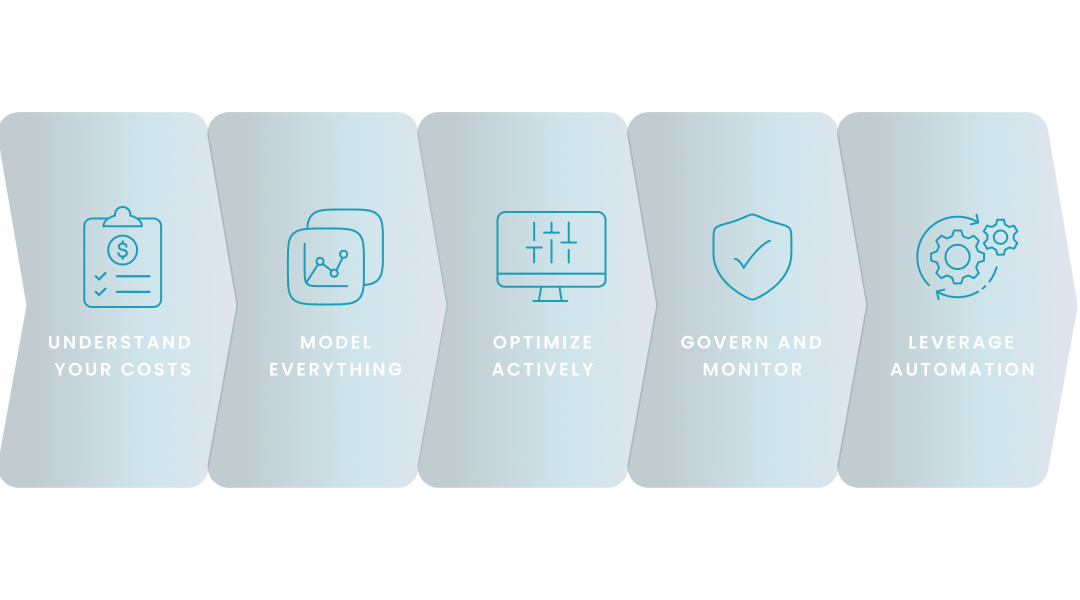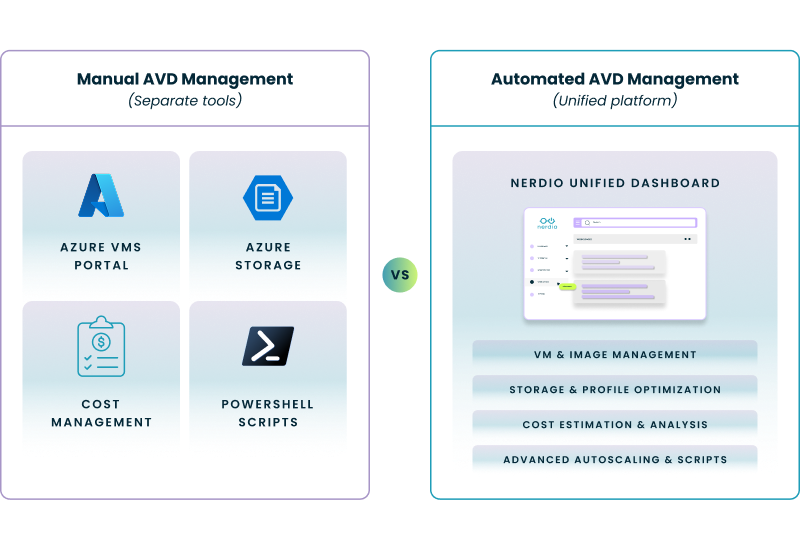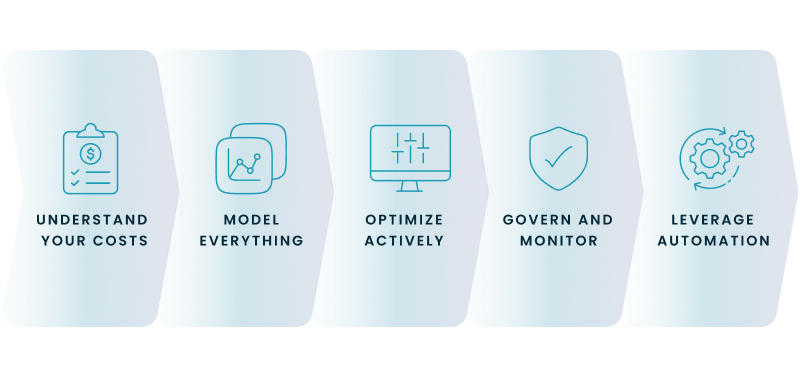NERDIO GUIDE


NERDIO GUIDE
Amol Dalvi | August 18, 2025
Ultimately, budgeting for fluctuating AVD demand requires a hybrid model using Reserved Instances for baseline costs and autoscaling for variable user loads.
This is because Azure Virtual Desktop (AVD) operates on a consumption-based model, meaning you pay for the Azure resources your users consume. The primary challenge is forecasting these costs when user demand is unpredictable, making it difficult to balance a responsive user experience with strict IT budgets.
To build an accurate budget, you first need a granular understanding of every component that contributes to your monthly Azure bill. For many organizations, the choice between virtual desktop solutions depends on the pricing model; AVD's consumption-based pricing is often more cost-effective for shared, multi-session scenarios or fluctuating workloads, while the fixed per-user cost of Windows 365 offers budget predictability for dedicated, full-time users.
These costs go far beyond the virtual machines themselves and include storage, networking, and specific licensing considerations. The table below identifies the four main AVD cost drivers and shows how much compute costs can decrease between an unoptimized and fully optimized environment:
| Cost Category | Unoptimized Environment | Moderately Optimized Environment | Highly Optimized Environment |
|---|---|---|---|
| Compute | 65 - 75% | 45 - 55% | 35 - 45% |
| Storage | 15 - 20% | 20 - 30% | 25 - 35% |
| Networking | 5 - 10% | 10 - 20% | 15 - 25% |
| Licensing & Management | 3 - 8% | 5 - 15% | 10 - 20% |
Compute costs are for the virtual machines (VMs) that run your AVD session hosts and are typically the largest part of your bill. The primary factors influencing this cost are:
Storage costs are generated by the data your AVD environment requires, which falls into two main categories:
Networking costs can be less predictable but are critical to budget for. The main driver here is data egress.
This is a common point of confusion. Many existing Microsoft 365 and Windows enterprise licenses include the access rights for AVD, meaning you don't pay extra for the Windows license itself. However, these licenses do not cover the Azure infrastructure costs (compute, storage, networking) detailed above, which are billed separately based on consumption.
This step-by-step wizard tool gives you the total cost of ownership for AVD in your organization.
A reactive "wait and see" approach to AVD costs can lead to significant budget overruns. To gain control, you need a proactive, strategic framework that allows you to model expenses and make data-driven decisions, even when faced with volatility. Here we answer top questions we hear from customers.
You budget for fluctuating Azure Virtual Desktop (AVD) demand by creating a hybrid cost model. First, establish a baseline cost for your minimum required users with discounted Azure Reserved Instances, then use pay-as-you-go pricing with autoscaling to handle variable demand. It's also wise to include a contingency fund of 10-15% in your budget to cover unexpected usage spikes.
To budget effectively, you should also model costs based on different user personas (e.g., task worker vs. power user) to create a more accurate forecast. You'll also want to use tools like Azure Cost Management with consistent resource tagging to actively monitor spending and set up alerts for unexpected AVD cost spikes. This data-driven approach allows you to spot trends and adjust your strategy proactively instead of reactively, often by leveraging both these native tools and third-party automation platforms for monitoring AVD costs.
You can't forecast without a starting point. The most reliable way to get one is to run a pilot program with a representative sample of users for a set period (e.g., 30-60 days). This real-world data is far more accurate than any on-paper estimate and will form the foundation of your entire budget model.
Not all users have the same resource needs. By segmenting your users into personas, you can create a highly accurate cost model that scales with your organization. This avoids the trap of over-provisioning for everyone or under-powering your most demanding users.
| Persona | Example Role | Typical Applications | Recommended VM Series |
|---|---|---|---|
| Task Worker | Call Center Agent, Data Entry | Microsoft 365, Web Browser, 1–2 Line-of-Business Apps | Dsv5-series |
| Knowledge Worker | Marketing Manager, Analyst | Full Microsoft 365 Suite, Teams, Power BI, Web Conferencing | Dsv5 or Esv5-series |
| Power User | Software Developer, IT Admin | IDEs (Visual Studio), Docker, Multiple Browsers, Admin Tools | Dsv5 or Esv5-series |
| Engineer / Designer | CAD Engineer, Graphic Designer | AutoCAD, Revit, Adobe Creative Suite | NVv4 or NVadsA10 v5-series (GPU-enabled) |
Your business isn't static, and your AVD budget shouldn't be either. Identify and plan for predictable fluctuations in user demand. Examples include:
Even the best models can't predict everything. It is a financial best practice to build a contingency fund into your AVD budget, typically 10-15% of your total projected cost. This fund covers unforeseen events like urgent M&A activity requiring rapid user onboarding, a sudden large-scale shift to remote work, or unexpected project demands.
Once you have a budget, the key is using technical strategies like automation and auto-scaling to manage AVD cost and performance effectively. These are the active, hands-on levers you can pull within your AVD environment to align real-time spending with your forecast.
Autoscaling is your most powerful tool for managing unpredictable demand. It automatically adjusts the number of available session host VMs based on user load, ensuring you only pay for what you need. Key strategies include:
The most cost-effective AVD environments use a hybrid approach. The goal is to cover your predictable, baseline workload with RIs and handle everything else with the flexibility of PAYG.
An inefficient session host is a constant drain on your budget. "Right-sizing" is the process of matching VM resources to actual user requirements to avoid paying for unused capacity. Advanced strategies can even automate the process of right-sizing AVD images based on performance data, ensuring resources continually match user needs without manual intervention. Key optimizations include:
Resource tagging is a critical governance practice. By applying tags (e.g., Department:Finance, Project:Q4-Audit) to your AVD resources, you can filter and group costs within Azure Cost Management. This allows you to perform accurate showback or chargeback to business units, transforming IT from a cost center into a strategic partner.
While Azure provides a powerful set of native tools, manually implementing all of the strategies above requires deep expertise, custom scripting, and constant monitoring. A unified AVD management and automation platform eliminates this complexity by providing a single interface to control costs, manage infrastructure, and optimize performance.

For example, a platform like Nerdio Manager for Enterprise is built specifically to operationalize these best practices. It directly addresses the challenges of budgeting for unpredictable demand by providing factual, verifiable automation capabilities:
See this demo to learn how you can optimize processes, improve security, increase reliability, and save up to 70% on Microsoft Azure costs.
See how you can optimize processes, improve security, increase reliability, and save up to 70% on Microsoft Azure costs.
Achieving financial control over a dynamic AVD environment is entirely possible with the right strategy and tools. A successful approach moves beyond simple monitoring to active, intelligent management of your resources.

This step-by-step wizard tool gives you the total cost of ownership for AVD in your organization.



Software product executive and Head of Product at Nerdio, with 15+ years leading engineering teams and 9+ years growing a successful software startup to 20+ employees. A 3x startup founder and angel investor, with deep expertise in Microsoft full stack development, cloud, and SaaS. Patent holder, Certified Scrum Master, and agile product leader.